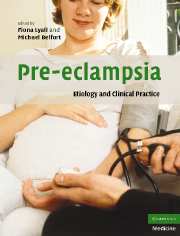Book contents
- Frontmatter
- Contents
- List of contributors
- Preface
- Part I Basic science
- Part II Clinical Practice
- 17 Classification and diagnosis of pre-eclampsia
- 18 Measuring blood pressure in pregnancy and pre-eclampsia
- 19 Immune maladaptation in the etiology of pre-eclampsia; an updated epidemiological perspective
- 20 Genetics of pre-eclampsia and counseling the patient who developed pre-eclampsia
- 21 Thrombophilias and pre-eclampsia
- 22 Medical illness and the risk of pre-eclampsia
- 23 The kidney and pre-eclampsia
- 24 Management of mild pre-eclampsia
- 25 Management of severe pre-eclampsia
- 26 The differential diagnosis of pre-eclampsia and eclampsia
- 27 Complications of pre-eclampsia
- 28 Central nervous system findings in pre-eclampsia and eclampsia
- 29 Pathogenesis and treatment of eclampsia
- 30 Anesthesia for the pre-eclamptic patient
- 31 Critical care management of severe pre-eclampsia
- 32 The role of maternal and fetal Doppler in pre-eclampsia
- 33 Pregnancy-induced hypertension – the effects on the newborn
- 34 Medico-legal implications of the diagnosis of pre-eclampsia
- Subject index
- References
25 - Management of severe pre-eclampsia
from Part II - Clinical Practice
Published online by Cambridge University Press: 03 September 2009
- Frontmatter
- Contents
- List of contributors
- Preface
- Part I Basic science
- Part II Clinical Practice
- 17 Classification and diagnosis of pre-eclampsia
- 18 Measuring blood pressure in pregnancy and pre-eclampsia
- 19 Immune maladaptation in the etiology of pre-eclampsia; an updated epidemiological perspective
- 20 Genetics of pre-eclampsia and counseling the patient who developed pre-eclampsia
- 21 Thrombophilias and pre-eclampsia
- 22 Medical illness and the risk of pre-eclampsia
- 23 The kidney and pre-eclampsia
- 24 Management of mild pre-eclampsia
- 25 Management of severe pre-eclampsia
- 26 The differential diagnosis of pre-eclampsia and eclampsia
- 27 Complications of pre-eclampsia
- 28 Central nervous system findings in pre-eclampsia and eclampsia
- 29 Pathogenesis and treatment of eclampsia
- 30 Anesthesia for the pre-eclamptic patient
- 31 Critical care management of severe pre-eclampsia
- 32 The role of maternal and fetal Doppler in pre-eclampsia
- 33 Pregnancy-induced hypertension – the effects on the newborn
- 34 Medico-legal implications of the diagnosis of pre-eclampsia
- Subject index
- References
Summary
Introduction
Hypertensive disorders are the most common medical complication of pregnancy, affecting 6–8% of all pregnancies (National High Blood Pressure Working Group, 2000). Approximately 30% of hypertensive disorders in pregnancy are due to chronic hypertension and 70% are due to gestational hypertension–pre-eclampsia. The spectrum of disease ranges from mildly elevated blood pressures with minimal clinical significance to severe hypertension and multi-organ dysfunction.
Severe pre-eclampsia is a clinical syndrome that can progress rapidly to an obstetric emergency. It embraces a spectrum of signs and symptoms, primarily systolic or diastolic blood pressure (BP) exceeding 160 or 110 mmHg, respectively, significant proteinuria (>5 g in a 24 h specimen), and evidence of end-organ damage. In healthy nulliparous women, the rate of severe pre-eclampsia is 2–3% (Sibai et al., 1993). It accounts for a significant proportion of indicated preterm deliveries and contributes to maternal and neonatal morbidity and mortality (Kurkinen-Raty et al., 2000; Mackay et al., 2001; Waterstone et al., 2001). Until recently, women with severe pre-eclampsia were delivered without delay regardless of gestational age. When pre-eclampsia occurred remote from term, this practice usually resulted in a nonviable fetus or an extremely low-birthweight infant. Not until the early 1980s was expectant management considered a legitimate option for severe pre-eclampsia.
- Type
- Chapter
- Information
- Pre-eclampsiaEtiology and Clinical Practice, pp. 369 - 379Publisher: Cambridge University PressPrint publication year: 2007



